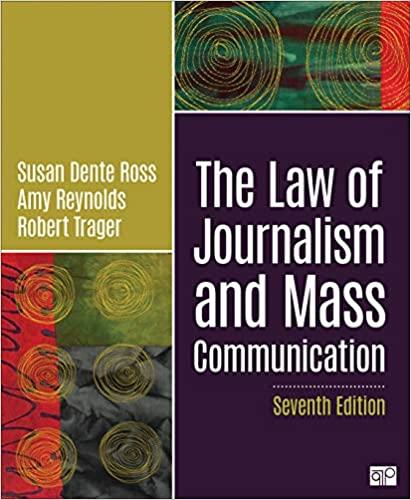Question
Read about the McDonald's Hot Coffee Lawsuit below. Pick a party in your initial post, either Stella or McDonald's. Put yourself in Stella Liebeck's place.
Read about the McDonald's Hot Coffee Lawsuit below. Pick a party in your initial post, either Stella or McDonald's.
Put yourself in Stella Liebeck's place. What legal actions might you have taken after suffering this injury? Did you have a preconceived opinion of the merits of her claim? Do you believe that her lawsuit was frivolous? Why or why not? (Use this definition of "frivolous")
Put yourself in McDonald's' position as a business organization. Here are some suggestions. Why did McDonald's want to try this case? Would you have settled it? What would be your justification for not reducing the coffee's temperature? What does it mean that the 700 previous claims were "statistically insignificant?"
The Lawsuit about McDonald's Hot Coffee:
Stella Liebeck sued McDonald's for burns she suffered after spilling a cup of its take-out coffee in her lap. The coffee that burned Liebeck was 180 degrees, 15-20 degrees hotter than coffee typically served in restaurants. The jury considered whether McDonald's acted improperly in selling 180-degree (or hotter) coffee that was significantly hotter than a consumer would expect from common experience. Stella Liebeck incurred third-degree burns, received skin grafts, and spent seven days in the hospital.
Testimony at trial showed that before the lawsuit, McDonalds had received over 700 complaints about burns, some of them third-degree, suffered by customers who spilled coffee on themselves, and had paid out nearly three quarters of a million dollars to settle the claims, including some payments as large as $66,000. A McDonald's executive testified that McDonald's knew of the risk of burns caused by its hotter-than-average coffee and knew that most customers did not realize the specific risk posed by coffee at those temperatures, but nevertheless did not intend to warn customers of the risk. A safety consultant for McDonald's testified that 700 complaints were "statistically insignificant" relative to the billion cups of coffee McDonald's served over a year. The suit was not about a mere failure to warn that coffee is hot; it was about failure to warn of the danger created by serving materially hotter-than-normal coffee to customers who knew they were buying something hot.
The McDonald's coffee lawsuit demonstrates the many factors that can figure into resolution of a personal injury claim, from the initial request for payment of medical bills (a negotiation) to a jury verdict and ultimate resolution by settlement. It is also an example of the many theories of liability a plaintiff may rely on in pursuing her claim. Mrs. Liebeck claimed that the coffee as served was excessively hot and McDonald's was liable under the theory of strict liability. She also alleged an absence of care and foreseeability of harm under a negligence theory, gross negligence, willful and wanton disregard of her rights, safety, and welfare, and for the marketing defect of no warning, or in the alternative, insufficient warning, because McDonald's Corporation and McDonald's Restaurants P.T.S., Inc. fully knew of and were aware of innumerable burn cases caused by the fault, or in the alternative, negligence of their operations in the manufacture, sale, and marketing of extremely hot coffee. She also made claims under implied warranties. Among other defenses, McDonald's claimed her injuries were a result of her own negligence.
The jury found for Mrs. Liebeck on her claims of product defect, breach of implied warranty of merchantability, and breach of the implied warranty of fitness for a particular purpose. The jury also found that she was twenty percent at fault.





Step by Step Solution
There are 3 Steps involved in it
Step: 1

Get Instant Access to Expert-Tailored Solutions
See step-by-step solutions with expert insights and AI powered tools for academic success
Step: 2

Step: 3

Ace Your Homework with AI
Get the answers you need in no time with our AI-driven, step-by-step assistance
Get Started


